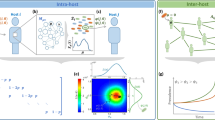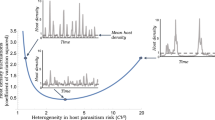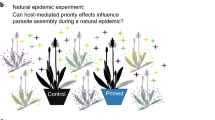Abstract
SIMPLE mathematical models for microparasites offer a useful way to examine the population dynamics of different viral and bacterial pathogens. One constraint in applying these models in free-living host populations is the paucity of data with which to estimate transmission rates. Here we recast a standard epi-demiological model by setting the birth and death rates of the host population and its density as simple allometric functions of host body weight. We then use standard threshold theorems for the model in order to estimate the minimum rate of transmission for the parasite to establish itself in a mammalian host population. Transmission rates that produce different comparable values of the parasites' basic reproductive number, R0, are themselves allometric functions of host body size. We have extended the model to show that hosts having different body sizes suffer epidemic outbreaks whose frequency scales with body size. The expected epidemic periods for pathogens in different mammalian populations correspond to cycles observed in free-living populations.
This is a preview of subscription content, access via your institution
Access options
Subscribe to this journal
Receive 51 print issues and online access
$199.00 per year
only $3.90 per issue
Buy this article
- Purchase on Springer Link
- Instant access to full article PDF
Prices may be subject to local taxes which are calculated during checkout
Similar content being viewed by others
References
Anderson, R. M. & May, R. M. Infectious Diseases of Humans: Dynamics and Control (Oxford Univ. Press, 1992).
Anderson, R. M. & Trewhella, W. Phil. Trans R. Soc. Lond. B 310, 327–381 (1985).
Fowler, C. W. Ecology 62, 602–610 (1981).
Kermack, W. O. & McKendrick, A. G. Proc. R. Soc. Lond. A 115, 700–721 (1927).
Anderson, R. M. & May, R. M. Nature 280, 361–367 (1979).
Antonovics, J., Iwasa, J. Y. & Hassell, M. P. Am. Nat. 145, 661–675 (1995).
Thrall, P. H., Biere, A. & Uyenoyama, M. K. Am. Nat. 145, 43–62 (1995).
Anderson, R. M. & May, R. M. Phil. Trans. R. Soc. Lond. B 291, 451–524 (1981).
Grenfell, B. T. & Dobson, A. P. Infectious Diseases in Natural Populations (Cambridge Univ. Press, 1995).
Peters, R. H. The Ecological Implications of Body Size (Cambridge Univ. Press, 1983).
Calder, W. A. Size, Functions and Life History (Harvard Univ. Press, Boston. 1984).
Schmidt-Nielsen. K. Scaling: Why is Animal Size so Important? (Cambridge Univ. Press, 1984).
Charnov, E. L. Life History Invariants (Oxford Univ. Press, 1993).
Silva, M. & Downing, J. A. Am. Nat. 145, 704–727 (1995).
Peterson, R. O., Page, R. E. & Dodge, K. M. Science 224, 1350–1352 (1984).
Mollison, D. Nature 310, 224–225 (1984).
Author information
Authors and Affiliations
Rights and permissions
About this article
Cite this article
De Leo, G., Dobson, A. Allometry and simple epidemic models for microparasites. Nature 379, 720–722 (1996). https://doi.org/10.1038/379720a0
Received:
Accepted:
Issue Date:
DOI: https://doi.org/10.1038/379720a0
This article is cited by
-
Towards an ecosystem model of infectious disease
Nature Ecology & Evolution (2021)
-
Association between body size and reservoir competence of mammals bearing Borrelia burgdorferi at an endemic site in the northeastern United States
Parasites & Vectors (2015)
-
Ecological morphotaxometry of trematodes of garfish (Teleostomi: Belonidae) from Gangetic riverine ecosystem in India. II. Correlation of seasonality and host biology with distribution pattern of Cephalogonimus yamunii n.sp.
Journal of Parasitic Diseases (2013)
Comments
By submitting a comment you agree to abide by our Terms and Community Guidelines. If you find something abusive or that does not comply with our terms or guidelines please flag it as inappropriate.



